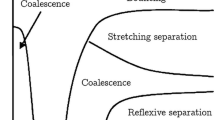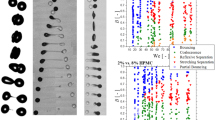Abstract
It has been recently proposed to use drop collisions for producing advanced particles or well-defined capsules, or to perform chemical reactions where the merged drops constitute a micro-reactor. For all these promising applications, it is essential to determine whether the merged drops remain stable after the collision, forming a single entity, or if they break up. This topic, widely investigated for binary drop collisions of miscible and immiscible liquid, is quite unexplored for ternary drop collisions. The current study aims to close this gap by experimentally investigating collisions between three equal-sized drops of the same liquid arranged centri-symmetrically. Three drop generators are simultaneously operated to obtain controlled ternary drop collisions. The collision outcomes are observed via photographs and compared to those of binary collisions. Similar to binary collisions, a regime map is built, showing coalescence and bouncing as well as reflexive and stretching separation. Significant differences are observed in the transitions between these regimes.















Similar content being viewed by others
References
Ashgriz N, Poo JY (1990) Coalescence and separation in binary collisions of liquid drops. J Fluid Mech 221:183–204
Brazier-Smith PR, Jennings SG, Latham J (1972) The interaction of falling water drops: coalescence. Proc R Soc Lond 326:393–408
Brenn G, Frohn A (1989) Collision and coalescence of droplets of various liquids. J Aerosol Sci 20:1027–1030
Brenn G, Durst F, Tropea C (1996) Monodisperse sprays for various purposes—their production and characteristics. Part Part Syst Charact 13:179–185
Dubois P, Marchand G, Fouillet Y, Berthier J, Douki T, Hassine F, Gmouh S, Vaultier M (2006) Ionic liquid droplet as e-microreactor. Anal Chem 78:4909–4917
Frenz L, El Harrak A, Pauly M, Bégin-Colin S, Griffiths AD, Baret JC (2008) Droplet-based microreactors for the synthesis of magnetic iron oxide nanoparticles. Angew Chem 47:6817–6820
Gotaas C, Havelka P, Jakobsen HA, Svendsen HF, Hase M, Roth N, Weigand B (2007) Effect of viscosity on droplet–droplet collision outcome: experimental study and numerical comparison. Phys Fluids 19:102106
Jiang YJ, Umemura A, Law CK (1992) An experimental investigation in the collision behaviour of hydrocarbon droplets. J Fluid Mech 234:171–190
Li Y, Yan L, Liu Y, Qian K, Liu B, Yang P, Liu B (2015) High-efficiency nano/micro-reactors for protein analysis. RSC Adv 5:1331–1342
Montgomery DN (1970) Collision and coalescence of water drops. J Atmos Sci 28:291–293
Orme M (1997) Experiments on droplet collisions, bounce, coalescence and disruption. Prog Energy Combust Sci 23:65–79
Planchette C (2011) Collisions de gouttes asymétriques. Ph.D. thesis, Université de Paris-Est Marne-la-Vallée
Planchette C, Lorenceau E, Brenn G (2010) Liquid encapsulation by binary collisions of immiscible liquid drops. Colloids Surf A 365:89–94
Planchette C, Lorenceau E, Brenn G (2012) The onset of fragmentation in binary liquid drop collisions. J Fluid Mech 702:5–25
Qian J, Law CK (1997) Regimes of coalescence and separation in droplet collision. J Fluid Mech 331:59–80
Rayleigh JWS (1896) The theory of sound, vol II, 2nd edn. Macmillan & Co., London
Song H, Chen DL, Ismagilov RF (2006) Reactions in droplets in microfluidic channels. Angew Chem 45:7336–7356
Stone HA, Leal LG (1989) Relaxation and breakup of an initially extended drop in an otherwise quiescent fluid. J Fluid Mech 198:399–427
Stone HA, Bentley BJ, Leal LG (1986) An experimental study of transient effects in the breakup of viscous drops. J Fluid Mech 173:131–158
Willis KD, Orme M (2000) Experiments on the dynamics of droplet collisions in a vacuum. Exp Fluids 29:347–358
Willis KD, Orme M (2003) Binary droplet collisions in a vacuum environment: an experimental investigation on the role of viscosity. Exp Fluids 34:28–41
Yeo Y, Basaran OA, Park K (2003) A new process for making reservoir-type microcapsules using ink-jet technology and interfacial phase separation. J Control Release 93:161–173
Yeo Y, Chen AU, Basaran OA, Park K (2004) Solvent exchange method: a novel microencapsulation technique using dual microdispensers. Pharm Res 21:1419–1427
Acknowledgments
Support for HH from the Research Center Pharmaceutical Engineering GmbH at Graz University of Technology is gratefully acknowledged. The authors acknowledge participation in the EU COST action MP 1106.
Author information
Authors and Affiliations
Corresponding author
Rights and permissions
About this article
Cite this article
Hinterbichler, H., Planchette, C. & Brenn, G. Ternary drop collisions. Exp Fluids 56, 190 (2015). https://doi.org/10.1007/s00348-015-2056-x
Received:
Revised:
Accepted:
Published:
DOI: https://doi.org/10.1007/s00348-015-2056-x




